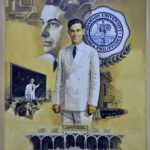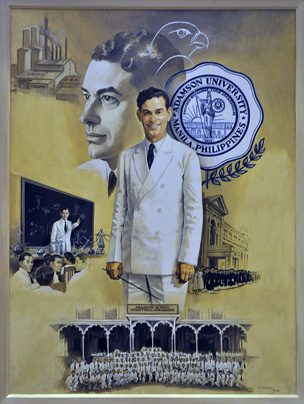 Adamson University in the Philippines is currently administered by the priests and brothers of the Congregation of the Mission. But why is it called Adamson University?
Adamson University in the Philippines is currently administered by the priests and brothers of the Congregation of the Mission. But why is it called Adamson University?
Generations of Filipino engineers, chemists and a host of other professionals in the field of sciences have a man by the name of George Lucas Adamson to thank for what they are today.
It was this Greek professor and doctor of philosophy who filled a significant void in the country’s tertiary educational system in the 1930s, which until then had only concentrated on humanities, medicine and law. Having settled in the Philippines with several profitable businesses, he noticed that the need for educating experts in the field of technology and industry had been overlooked and in effect limited the country’s economic and overall national development.
With countless graduates of Adamson University propelling local manufacturing industries, laboratories and construction companies for the last eight decades, it is but right that the life and times of Dr. George Lucas Adamson was finally immortalized on November 16, when the Adamson University Museum-Founder’s Wing was inaugurated to house priceless pieces of memorabilia that shows how the man devoted his very best years to the Philippines.
Work of love
 In an interview with The Sunday Times Magazine, Raul Agner of the university’s Institutional Development and External Affairs Office (IDEA) related that the museum is the outcome of the Vincentian community and the Adamson family’s deep love for their founder and patriarch. (The Vincentians are priests and brothers of the order of St. Vincent de Paul to whom Adamson passed on the university’s administration in 1964).
In an interview with The Sunday Times Magazine, Raul Agner of the university’s Institutional Development and External Affairs Office (IDEA) related that the museum is the outcome of the Vincentian community and the Adamson family’s deep love for their founder and patriarch. (The Vincentians are priests and brothers of the order of St. Vincent de Paul to whom Adamson passed on the university’s administration in 1964).
Several years in the making, the collaborative effort came from the team of Fr. Gregg Bañaga Jr., C.M., president of Adamson University; and the Adamson family, led by the celebrated expatriate’s only son, Dr. Lucas George Adamson.
Lucas George, who was born and raised in the Philippines but now resides in Spain, especially flew into Manila to share how the work of love began from both ends.
“No one paid attention to the worth of the volumes of documents, letters, and newspaper clippings and pieces of memorabilia that my mother [Evdoxia Savaides Adamson] had kept [after my father died in 1974],” he said in his speech. “That was, until Fr. Gregg encouraged us to collect them, not only to archive, but to make up this museum.
“We are therefore, deeply honored that the university is housing what my mother has had for many years. Even if it was difficult to convince her to turn them over,” he quipped.
It took the Adamsons, some two and half years of classifying stacks of materials that comprised the story of their patriarch’s journey to the Philippines; and his accomplishments as industrialist, educator, founder of the 80-year-old university, and diplomat. (Adamson served as Greek Consul General to the country and was chief delegate and signatory to the Treaty of Friendship between Greece and the Philippines).
Photographs and accompanying documents, correspondence and news clippings [many of which are from old issues of The Manila Times chronologically dot the well-planned museum, as designed and curated by a team from the Ayala Museum, headed by Kenneth Esguerra.
Beneath a lit panel that datelines important moments in world history and scientific discoveries, Adamson’s equally historical breakthroughs in Philippine industries, education and foreign relations are displayed on the main panes in a very impressive collage. He played a very active role in nurturing the students of the university, in community building, as well as in matters of national importance. Many photographs show how he had the honor and distinction of befriending and working with nine Filipino presidents, from Manuel Quezon all the way to Ferdinand Marcos.
To further help visitors appreciate Adamson’s numerous contributions to Philippine society, a book written by Lucas George’s wife, Theresa June Di Martile Adamson, was also launched during the inauguration, entitled Prof. Dr. George Lucas Adamson, Founder and President of Adamson University Manila Philippines—A Biography.
“My wife was very much a part of making the museum a reality,” Lucas George acknowledged. “I’d wake up many nights and see her pouring over the material and classifying them, which gave her the idea to write the book to supplement in detail what cannot be shown in the museum.
Theresa June, a Canadian entrepreneur, also spent many years in the Philippines after she married Lucas George. She gave birth and raised their two children here, [George Lucas and Dorothea], and was a first-hand witness to his father-in-law’s “love for the Philippines.”
In the same vein, proceeds from the sales of her book will go to the university’s College of Engineering scholars.
‘Love of honor’
Those who were fortunate to have met and worked with Dr. George Lucas Adamson during his almost four-decade stay in the Philippines witnessed how the professor faithfully lived the Greek virtue of “philotimo.”
According to the university’s profile on their founder, philotimo “translates to ‘love of honor’ characterized by a deep sense of obligation, nobility and moral pride.”
It is in his devotion to education that this virtue is best exemplified, for he was relentless in schooling his fellowmen despite many obstacles that came his way. Throughout his life, he was a firm believer that education is the key to a good future for everyone, regardless of age or nationality—and he made it his vocation to make learning available to as many people as possible.
Adamson first ventured in establishing a school back in Greece following the Greco-Turkish war in the 1920s. He had only begun a course in BS Chemistry at the University of Athens when the war broke out, and though his studies were interrupted when he served in the army, he strove to complete it, even if it meant going to school part-time.
Eager for his fellow soldiers to do the same, he ran a college-level preparatory school in 1924 for returning veterans to encourage them to go into university.
While he spent the next following years as a successful industrial chemist and businessman in Australia and later the Philippines, he devoted his time and resources to fulfil his “obligation” when he established the Adamson University.
Teaching the very first batch of students of what was then known as the Adamson School of Industrial Chemistry, he became known as the Pioneer of Industrial Education in the Philippines. From mere 42 students, his pupils grew to 200 and multiplied every year until the school became a full-fledged university in 1941.
However, in 1942, the Japanese occupation began and the university was raided, used a radio transmitting station, and finally burned to the ground before the liberation of Manila.
Unfazed, despite having been imprisoned together with his family as “enemy nationals,” Adamson re-built the university piece by piece, this time on the property of the St. Vincent de Paul priests.
Today, Adamson University proudly stands as a National Heritage Site, and rightly so, with the very words that its founder lived and continue to share with generations of Filipinos, emblazoned on the museum’s wall: “Education must transform the student into a rational individual whose idea of good transcends his own narrow limits so that he constantly strains for something higher and better for mankind.”
The Adamson University Museum is located at the university’s ground floor, SV Bldg, 900 San Marcelino Street, Ermita, Manila. Museum days and hours are on Monday to Friday, from 9 a.m. to 12 noon, and 1 p.m. to 5 p.m. For more information, log on to www.admason.edu.ph.
Sources: Adamson University Museum-Founder’s Wing brochure; Prof. Dr. George Lucas Adamson, Founder and President of Adamson University Manila Philippines—A Biography, by Theresa June Di Martile Adamson
Tags: Adamson University (Philippines), CM, Congregation of the Mission, Philippines

